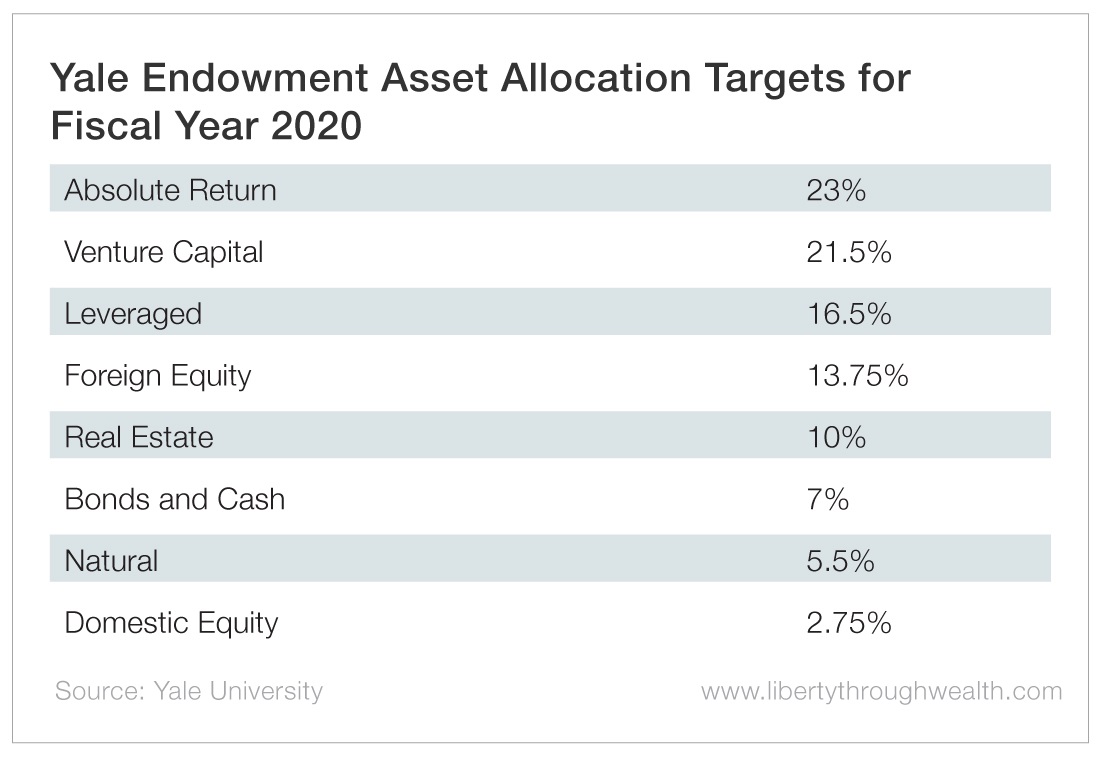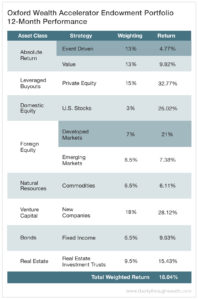- The Yale endowment’s massive success would be impossible for an individual investor to achieve… Or would it?
- Today, Nicholas Vardy shares how it fares as an ETF portfolio strategy.
A year ago, I launched the Endowment Portfolio as part of my Oxford Wealth Accelerator trading service.
The portfolio is composed of “buy and hold” exchange-traded funds (ETFs) that mimic the asset allocation strategy of the Yale University endowment. It is exclusively available to lifetime Members of Oxford Wealth Accelerator and The Oxford Club.
The Endowment Portfolio was, in many ways, an experiment.
Could small investors duplicate the returns of the Yale endowment using publicly traded ETFs?
Based on the returns we’ve seen from the portfolio over its first 12 months, the answer is, so far, an emphatic yes.
Let me explain.
The Yale Endowment
The investment strategy of the Endowment Portfolio was inspired by the Yale University endowment – widely considered the leader among all university endowments.
Over the past 20 years, the average return of college endowments was about 6.5%.
Yale’s return was close to double that, at 11.4%.
So what is Yale’s secret sauce?
The Yale endowment was the first to apply modern portfolio theory (MPT) to multibillion-dollar endowments.
According to MPT, asset allocation explains more than 90% of a portfolio’s investment returns.
By investing in a range of asset classes far beyond traditional U.S. stocks and bonds, you can construct a portfolio that generates higher returns at a lower risk.
David Swensen – who took over the Yale endowment in 1986 – took this argument for diversification to an extreme.
Over the past 30-plus years, Yale shifted the bulk of its investments into “alternative assets.” This strategy includes sizable allocations to natural resources, venture capital, real estate and foreign stocks.
As a result, the Yale endowment today looks very different from the average investor’s portfolio.
Yale Asset Allocation Strategy for 2020

You might be wondering whether Yale’s experience is relevant to your investment portfolio. The short answer is yes.
Swensen has argued that you have no chance of matching Yale’s market-beating returns.
After all, you can’t invest in venture capital or private equity. And besides, Yale invests with the top investment managers in the world.
Here’s why I disagree.
A 2010 study in The Journal of Wealth Management examined whether you could replicate Yale’s results using index funds. It concluded that “consistent exposure to diversified, risk-tilted, equity-oriented assets” explains a big chunk of the Yale endowment returns.
Today, ETFs allow you to mimic the Yale endowment’s asset allocation strategy.
And that is precisely what Oxford Wealth Accelerator‘s Endowment Portfolio does.
Returns on Our Endowment Portfolio and Yale’s
Because Oxford Wealth Accelerator‘s Endowment Portfolio was instituted in December 2018 and the Yale endowment operates on a fiscal year (the latest ending in June 2019), we don’t yet have a full overlapping year with which to make an apples-to-apples comparison of the two’s returns.
That said, the Yale endowment returned 5.7% over the 12 months that ended on June 30. (Those returns have likely increased since, thanks to the recent market rally.)
In 2019, our Endowment Portfolio generated the kind of steady gains you’d expect from a diversified portfolio.
Based on the closing prices on December 17, the portfolio delivered a return of 18.04% over the prior 12 months.
And it has gained 19.09% year to date.
Insights From the Endowment Portfolio’s 2019 Performance
There’s a lot you can learn just by looking at our portfolio’s returns and where they came from.

First, every asset class in the portfolio ended the year in the black. The rising tide in financial markets lifted all boats. And that was certainly the case in 2019.
Second, the highest-risk asset classes – private equity and venture capital – fared the best. Each generated returns of at least 20% over the past 12 months.
Third, emerging markets and commodities continued to disappoint. Both of these asset classes have been in long-term bear markets. But you can expect these asset classes to soar the most once the tide turns.
From the portfolio’s performance so far, one takeaway is clear: The Endowment Portfolio is a diverse, strong and largely underutilized alternative to traditional U.S. stock and bond asset allocation strategies.
Good investing,
Nicholas
Interested in hearing more from Nicholas? Follow @NickVardy on Twitter.
